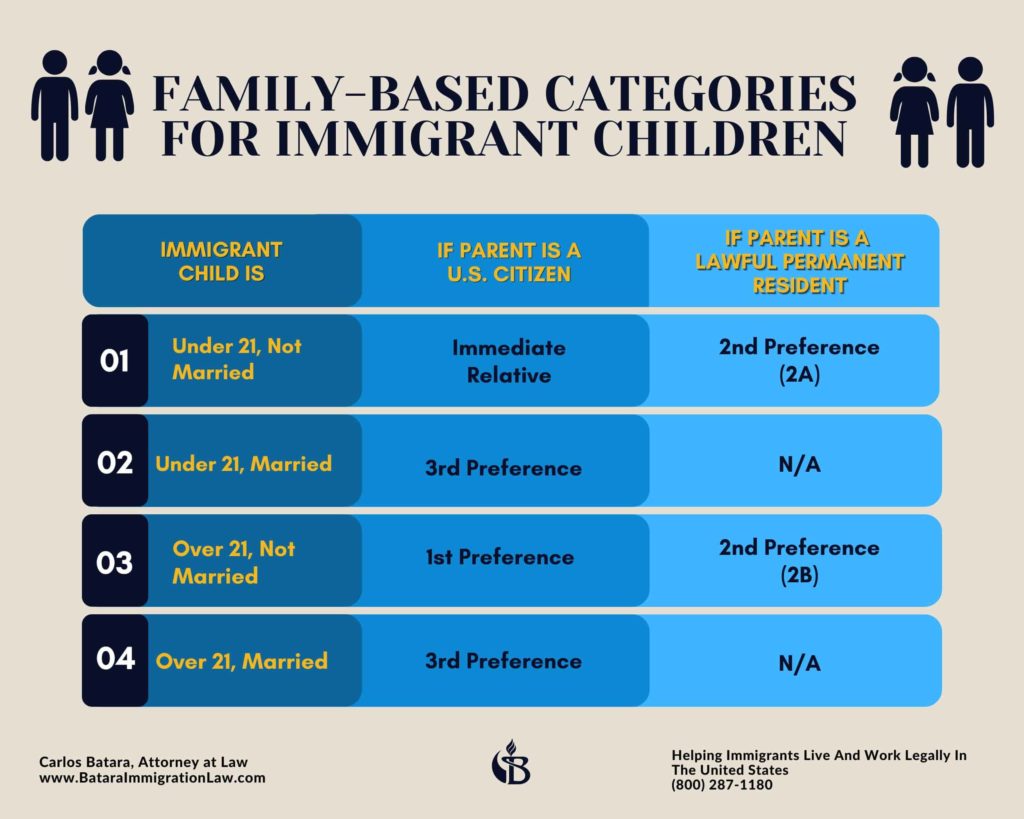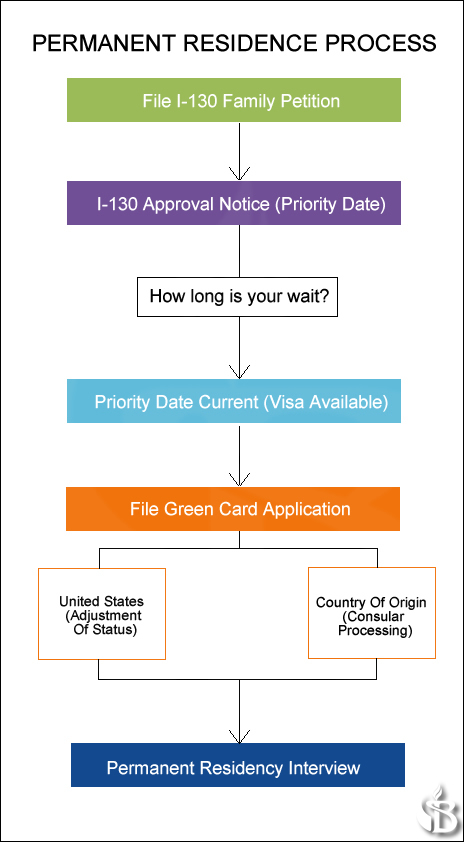
Family immigration has long been a foremost principle of United States immigration law.
The process of bringing family members together, known as family unification, enables U.S. citizen and permanent resident parents to sponsor their children for green card status and the opportunity to later apply for U.S. citizenship.
In some cases, the process occurs entirely within the United States. In others, the child will seek permanent residence through a U.S. Embassy or Consulate in their home country.
Both require adherence to strict guidelines, definitions, and rules. To help ensure success in unifying your family, this article discusses six issues you need to understand about filing for and winning a green card for your son or daughter.
Table Of Contents
- Who Qualifies As A Child Under Immigration Law?
- Can A Permanent Resident Sponsor His Child For A Green Card?
- Family Distinctions: Who Is Eligible To Be Petitioned For A Child Green Card?
- What Are The Steps To Apply For A Child Green Card?
- Child Green Cards: Where Does The Permanent Residence Interview Take Place?
- Does A Minor Child Have To Attend A Permanent Resident Interview?
- Conclusion
1. Who Qualifies As A Child
Under Immigration Law?
At first glance, this seems like a simple, almost silly, question.
However, the rules for immigrant children can get tricky.
To begin, for green card purposes, the term “child” has a special meaning. The keys are (a) marital status and (b) age.
In common, everyday language, people commonly refer to their sons and daughters as their children on an interchangeable basis.
Not so under immigration law.
Consider the following differentiations between “children” versus “sons and daughters” under immigration law:
Children: Unmarried And
Under 21 Years Of Age
If your son or daughter is unmarried and under 21 years, then your son or daughter is a “child” under immigration law.
Sons And Daughters: Married
Or Over 21 Years Of Age
If your son or daughter are married, but under 21, they are not children under immigration family visa rules. Immigration law calls them “daughter” and “son.”
If your son or daughter are over 21, but not married, they are not considered children. Again, they are deemed a “son” and a “daughter” under immigration regulations.
Do not minimize the distinction.
For more information about immigrating children in Hemet, contact Batara Immigration Services.
What if your son was married at the age of 18, but divorced a year later? He is now 20 years old.
If you file papers for him today, he is a “child” because he is now unmarried and still under 21.
Once he turns 21, he is now your “son.”
Why is this important?

As the family visas chart, above, illustrates, a child of a U.S. citizen is classified as an immediate relative. This means his or her paperwork will move relatively quickly through the immigrant relative petition process.
On the other hand, the son or daughter of a U.S. citizen can only file for permanent residence under the family preference system. The immigrant visa process under the family preference system is much slower. In some cases, the wait can be up to 20 years or more.
In other words, when it comes to immigration, the differentiation is more than merely semantics.
2. Can A Permanent Resident Sponsor His Child For A Green Card?
Yes and No.
Again, the child’s marital status and age makes a difference.
- A permanent resident can sponsor a child under 21, who is unmarried, for a green card.
- But a permanent resident cannot sponsor a child under 21, who is married, for a green card.
- A permanent resident can sponsor a son or daughter over 21, who is unmarried, for a green card.
- But a permanent resident cannot sponsor a son or daughter over 21, who is married, for a green card.
3. Family Distinctions: Who Is Eligible To Be Petitioned For A Child Green Card?
Of course, the distinction between the legal definitions of “children” versus “sons and daughters” is not all that parents of immigrant parents need to know.
Immigration law is never that simple.
Figuring out who is eligible for a child green card has a few more nuances we need to consider. We’ll turn now to different types of families.
Because many families do not consist solely of persons with biological and genetic ties, immigrant law has divided children into different categories, each with different rules.
- Genetic children born in wedlock
- Step-children based on a genetic parent’s marriage to another person
- Adopted children
- Genetic children born out of wedlock
- Children born through Assisted Reproductive Technology
Immigrant Stepchildren
If you marry someone, and either you or your new spouse has a child under 18, a valid stepparent-stepchild relationship exists for immigration purposes for family preference beneficiaries.
It might be that you will file for a green card for your stepchild. Or it could be that you have an immigrant child, born outside the U.S., who will be sponsored by your new spouse for permanent residence.
18 years old.
Adopted Immigrant Children
Adoptions of immigrant children must take place before he or she is 16 years old.
In addition, the child is required to have been in your or your husband’s legal and physical custody for two years before the adoption (depending on who is filing the child green card petition) and before the family I-130 petition to immigrate your adopted child is filed.
Children Born Out Of Wedlock
A child born “out of wedlock” means a child’s parents were not married at the time of birth.
For such children, the parent-child relationship through the mother will always qualify because it can be easily proved.
However, the father’s parent-child relationship will qualify in only two circumstances.
First, evidence must exist which clearly demonstrates a genuine parent-child relationship exists, such as the father financially supporting or living with the child; or
Second, the father must prove his child, before his 18th birthday, has been “legitimated”. This must be done in the manner prescribed by law in the country where the child is living.
In most cases, a birth certificate listing him as the father is sufficient evidence. In others, the father is not listed on the birth certificate and other types of evidence will be needed to show the child has been legitimated.
Children Born Via Assisted Reproductive Technology And Surrogacy Abroad
Recently, USCIS clarified the status of children born via assisted reproduction.
Children who are conceived through Assisted Reproductive Technology (ART), to a non-genetic, gestational mother, can be considered “minor” children – if the gestational mother is recognized under the law of the relevant jurisdiction as the child’s legal parent at the time of the child’s birth.
A gestational mother, also called a surrogate, is a woman who carries and delivers a child for another couple or individual. Because the gestational carrier does not provide the egg, she is not genetically related to the child.
4. What Are The Steps To Apply
For A Child Green Card?
All family-based green cards follow the same process – whether it’s a spouse, parent, sibling, or child who is being sponsored for permanent resident status.

- Once the I-130 petition is approved, the wait begins for an immigrant visa to become available.
- When this date is reached, the second stage of the permanent residence process starts. The green card paperwork is submitted and an interview is scheduled.
- At the second stage, there are two different pathways that immigrant relatives follow when submitting their paperwork and attending their interview. These are known as adjustment of status and consular processing.
5. Child Green Cards: Where Does The Permanent Residence Interview Take Place?
Family-based permanent residence law divides immigrant relatives into two classifications.
As part of the first step in the green card process, when you file an immigrant visa petition, you must submit evidence which category the child you intend to sponsor fits into.
Immediate Relatives
Many immigrant children who are classified as immediate relatives of U.S. citizens qualify for green card interviews in the United States. This is known as adjustment of status.
Simply stated, this means you are trying to change your immigrant status to a legal resident.
To qualify, immigrants must meet three requirements:
- Be present in the United States
- Have been admitted through a lawful entry (or legally equivalent inspection process)
- Have an immigrant visa available for them
Immediate relatives always have a visa available for them. As noted earlier, immigrant children, unmarried and under 21 years, of U.S. citizens are immediate relatives.
Hence, when their child green card petition is approved, the second step, filing of the green card application to adjust status to permanent resident, can begin. These cases move quickly.
Family Preference Beneficiaries
All other children who are qualified to apply for green cards through a U.S. citizen or permanent resident are placed into “preference categories” and are considered family preference beneficiaries.
These include children of U.S. citizens are either married or over 21.
In addition, as discussed earlier, children of permanent residents who are unmarried, over or under 21. (Married children of permanent residents are not eligible for green cards)
Some may be able to adjust status. For instance, a child who entered on a student visa, made a lawful admission and are physically present.
However, due to longer wait times for a visa to become available, adjustment of status is out of the question for most.
The vast majority of these children, sons, or daughters will attend their child green card interviews abroad, in their home country, at a U.S. embassy or consulate office. This is known as consular processing.
6. Does A Minor Child Have To Attend A Permanent Resident Interview?
Young children are not required to attend a green card interview. If the child is under 14, the government obtains the information it needs from a child’s parent.
If a child is 14 years or older, he must attend the interview with his parent. Generally, teens will be asked only basic questions, like verifying their identity and corroborating information listed in their application.
However, if a child and parent are part of the same petition, the child is often not required to be present at the interview.
If a child is 18 years of age or older, the interview process is essentially the same as it would be for any adult immigrant. The officer will go through your child’s application to ensure he or she qualifies for a child green card.
On the other hand, a parent may be required to attend the interview if the child and parent are both living in the same country. Thus, if a parent lives in the U.S. and the interview is taking place abroad, a parent is often not required to attend.
Conclusion
Do not underestimate the family immigration process for child green cards..
Too many immigrant children lose their cases because they or their parents made mistakes that could have been avoided, that should have been avoided.
As a result, some are sent to immigration court to face deportation charges. Others, applying from abroad, are not allowed to enter the U.S.
Parent and child face separation, perhaps forever.
Even if the family is allowed to start over, the ability to live with your children in the United States is deferred for several years.
Hopefully, this article will help steer you past such pitfalls.
Ready to take a serious and honest look at the strengths and weaknesses of your immigration case? Let’s get started with a personalized strategy and planning session . . .




